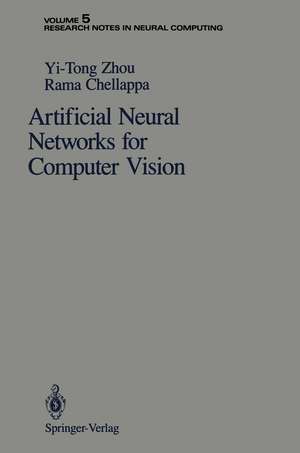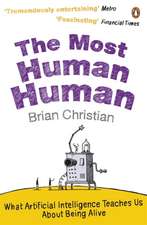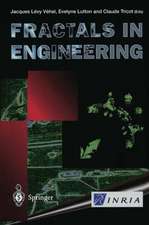Artificial Neural Networks for Computer Vision: Research Notes in Neural Computing, cartea 5
Autor Yi-Tong Zhou, Rama Chellappaen Limba Engleză Paperback – 23 dec 1991
Preț: 326.97 lei
Preț vechi: 408.71 lei
-20% Nou
Puncte Express: 490
Preț estimativ în valută:
62.57€ • 67.95$ • 52.56£
62.57€ • 67.95$ • 52.56£
Carte tipărită la comandă
Livrare economică 22 aprilie-06 mai
Preluare comenzi: 021 569.72.76
Specificații
ISBN-13: 9780387976839
ISBN-10: 0387976833
Pagini: 170
Ilustrații: XI, 170 p. 25 illus.
Dimensiuni: 155 x 235 x 10 mm
Greutate: 0.27 kg
Ediția:1992
Editura: Springer
Colecția Springer
Seria Research Notes in Neural Computing
Locul publicării:New York, NY, United States
ISBN-10: 0387976833
Pagini: 170
Ilustrații: XI, 170 p. 25 illus.
Dimensiuni: 155 x 235 x 10 mm
Greutate: 0.27 kg
Ediția:1992
Editura: Springer
Colecția Springer
Seria Research Notes in Neural Computing
Locul publicării:New York, NY, United States
Public țintă
ResearchCuprins
1 Introduction.- 1.1 Neural Methods.- 1.2 Plan of the Book.- 2 Computational Neural Networks.- 2.1 Introduction.- 2.2 Amari and Hopfield Networks.- 2.3 A Discrete Neural Network for Vision.- 2.4 Discussion.- 3 Static Stereo.- 3.1 Introduction.- 3.2 Depth from Two Views.- 3.3 Estimation of Intensity Derivatives.- 3.4 Matching Using a Network.- 3.5 Experimental Results.- 3.6 Discussion.- 4 Motion Stereo—Lateral Motion.- 4.1 Introduction.- 4.2 Depth from Lateral Motion.- 4.3 Estimation of Measurement Primitives.- 4.4 Batch Approach.- 4.5 Recursive Approach.- 4.6 Matching Error.- 4.7 Detection of Occluding Pixels.- 4.8 Experimental Results.- 4.9 Discussion.- 5 Motion Stereo—Longitudinal Motion.- 5.1 Introduction.- 5.2 Depth from Forward Motion.- 5.3 Estimation of the Gabor Features.- 5.4 Neural Network Formulation.- 5.5 Experimental Results.- 5.6 Discussion.- 6 Computation of Optical Flow.- 6.1 Introduction.- 6.2 Estimation of Intensity Values and Principal Curvatures.- 6.3 Neural Network Formulation.- 6.4 Detection of Motion Discontinuities.- 6.5 Multiple Frame Approaches.- 6.6 Experimental Results.- 6.7 Discussion.- 7 Image Restoration.- 7.1 Introduction.- 7.2 An Image Degradation Model.- 7.3 Image Representation.- 7.4 Estimation of Model Parameters.- 7.5 Restoration.- 7.6 A Practical Algorithm.- 7.7 Computer Simulations.- 7.8 Choosing Boundary Values.- 7.9 Comparisons to Other Restoration Methods.- 7.10 Optical Implementation.- 7.11 Discussion.- 8 Conclusions and Future Research.- 8.1 Conclusions.- 8.2 Future Research.


















